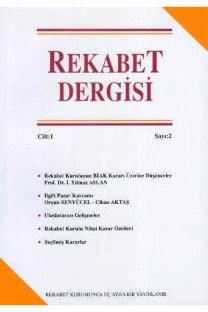ÜRÜN BAĞLAMA ve PAKET SATIŞLAR YOLUYLA HAKİM DURUMUN KÖTÜYE KULLANILMASI
Ürün bağlama ve paket satış uygulaması gündelik yaşamımızda çok farklı çeşitlerde karşımıza çıkmaktadır. Söz konusu uygulamaların yaygın olması ve genel kabul görmesi bir anlamda onların etkinliklerine işaret etmekle birlikte, bu özellikle hakim durumda olan ya da piyasa gücüne sahip olan teşebbüslerin yaptıkları bu tür uygulamaların piyasadaki rekabet üzerinde olumsuz etkileri olabileceği de görülmektedir. Bu çalışmada, ürün bağlama ve paketleme uygulamalarının iktisadi çerçevesinin çizilmesini müteakip, Amerika Birleşik Devletleri, Avrupa Birliği ve Türkiye’de alınan kararlar ışığında bunların ne şekilde değerlendirilmesi gerektiği tartışılmaktadır
Anahtar Kelimeler:
Ürün Bağlama, Paket Satışlar, Piyasayı Kapatma Teknolojik Bağlama, Ölçümleme Uygulamaları
ABUSE OF DOMINANT POSITION VIA TYING OR BUNDLING
Tying and bundling are common practices that we come across in different cloaks everyday. Even though their widespread application and recognition in business may point out their possible efficiencies, it is also seen that they may have anticompetitive effects, especially when they are employed by dominant undertakings or undertakings that have market power. In this paper, after exploring theoretical aspects of tying and bundling from the perspective of economics, prominent cases from three jurisdictions, namely US, EU and Turkish are discussed in order to bring a perspective on the assessment of tying and bundling practices
Keywords:
Tying Bundling, Foreclosure, Technologic Tying, Metering,
___
- AHLBORN, C., D. S EVANS ve A. J. PADILLA (2004). Antitrust Economics of Tying: A Farewell to Per Se Illegality, Antitrust Bulletin, 49: 287.
- ARDIYOK, Ş. (2007) “Rekabet Hukukunda Satış Sonrası Pazar Teorileri ve Motorlu Taşıtlar Tebliği’nin Ampirik Analizi”, Rekabet Hukukunda Güncel Gelişmeler Sempozyumu - V, Rekabet Kurumu Yayınları, Ankara.
- BAKOS, Y. ve E. BRYNJOLFSSON (1999) “Bundling Information Goods: Pricing, Profits and Efficinecy, Management Science, 45:1613
- BORK, R.H (1978), The Antitrust Paradox: A Policy At War With Itself, Free Press, New York.
- BOWMAN, W. S. Jr. (1957) “Tying Arrangements and the Leverage Problem”, The Yale Law Journal, 67: 19. CARBAJO, J., D. de MEZA ve D. J SEIDMANN (1990), “A Strategic Motivation for Commodity Bundling”, Journal of Industrial Economics 38: 283-298.
- CARLTON, D. W. ve M. WALDMAN (2002) “The Strategic Use of Tying to Preserve and Create Market Power in Evolving Industries”, The RAND Journal of Economics 33, no. 2 (Summer): 194-220.
- CARLTON, D. W. ve M. WALDMAN. (2005a). Theories of Tying and Implications for Antitrust. SSRN eLibrary (Temmuz).
- http://papers.ssrn.com/sol3/papers.cfm?abstract_id=809304
- Erişim Tarihi: 12.02.2010.
- CARLTON, D. W. ve M. WALDMAN (2005b), “How Economics Can Improve Antitrust Doctrine ToW.s Tie-In Sales: Comment on Tirole's 'An Analysis of Tying Cases: A Primer'”, Competition Policy International, Vol. , No. 1, pp. 27- 40, Spring 1.
- http://papers.ssrn.com/sol3/papers.cfm?abstract_id=702645
- Erişim Tarihi: 12.02.2010.
- CHEN, Y. (1997), “Equilibrium Product Bundling”, Journal of Business, s.85-103.
- CHIN, A. (2005), “Decoding Microsoft”, Wake Forest Law Review, Vol.40(1), s.1-157.
- CRANE, D. A. (2005) “Multiproduct Discounting: A Myth of Nonprice Predation”, The University of Chicago Law Review, Vol.72., No.1. s.27-84.
- COURNOT, A. (1838). Recherches sur les principes mathématiques de la théorie des richesses, Paris: Hachette. İngilizce çevirisi: çev. N. Bacon, Research into the Mathematical Principles of the Theory of Wealth, James and Gordon, Mountain Center, CA 1995.
- EKDİ, B. (2010), Hâkim Durumda Bulunan Teşebbüslerin Dikey Anlaşmalar Yoluyla Piyasayı Kapatması, Rekabet Kurumu Yayınları, Lisans Üstü Tez Serisi No.16., Ankara.
- EVANS, D. S. ve M. SALINGER (2005). “Why Do Firms Bundle and Tie - Evidence from Competitive Markets and Implications for Tying Law.” Yale Journal on Regulation 22: 37. GAYNOR, D. E. (2006) “Technological Tying”, FTC Working Papers, No.284. GELLHORN, E. ve W.E. KOVACIC (1994), Antitrust Law and Economics in a Nutshell, Fourth Edition, St. Paul: MN.
- HYLTON, K. N ve M. SALINGER (2001), “Tying Law and Policy: A Decision-Theoretic Approach”,.Antitrust Law Journal 69: 469.
- KOCABAŞ, B. (2008), İndirim Sistemleri ve Rekabet: Tek Taraflı Davranışlar Açısından Bir Değerlendirme, Rekabet Kurumu Yayınları Uzmanlık Tez Serisi, Ankara.
- NALEBUFF, B. (2000), “Bundling”, Yale ICF Working Paper, No. 99-14
- http://papers.ssrn.com/paper.taf?abstract_id=185193, Erişim Tarihi: 10.02.2010. NALEBUFF, B. (2003), “Bundling, Tying and Portfolio Effects Part I: Conceptual Issues”, DTI Economic Papers, No.1, Department of Trade and Industry, London, s. 13-16.
- NALEBUFF, B. ve D. MAJERUS (2003), “Bundling, Tying and Portfolio Effects Part 2: Case Studies”, DTI Economic Papers, No.1, Department of Trade and Industry, London, s. 13-16. PADILLA, A.J. and D.S. EVANS, “Tying Under Article 82 EC and the Microsoft Decision: A Comment on Dolmans and Graf.”. World Competition: Law and Economics Review, 2005. Available at SSRN
- http://ssrn.com/abstract=596663.
- PAPANDROPOULOS, P. (2006) “Article 82: Tying and bundling”, Competition Law Insight.
- POSNER, R.A. (2005), “Keynote Address: Vertical Restrictions and ‘Fragile’ Monopoly”, The Antitrust Bulletin, 50(3), pp. 499-509.
- POSNER, R.A. (2001), Antirust Law, 2nd Edition, Chicago: The University of Chicago Press.
- REKABET KURUMU (2009), Rekabet Terimleri Sözlüğü, Rekabet Kurumu Yayınları, 1. Baskı.
- http://www.rekabet.gov.tr/dosyalar/images/file/Ekonomi/1_BASKI%20REKAB ET_TERIMLERI.pdf
- SCHWARTZ, R.M. (2010), “Confusing 'Bundling' with 'Tying' Under Article 82 Ec: 'Batteries included' or 'It only comes with fries'”, Hastings Business Law Journal, 6:145.
- STIGLER, G. J. (1968), ORGANIZATION of INDUSTRY, The University of Chicago Press.
- TIROLE, J. (2005), “The Analysis of Tying Cases: A Primer”, SSRN eLibrary (Competition Policy International, Vol. , No. 1, pp. 1-25, Spring 1).
- http://papers.ssrn.com/sol3/papers.cfm?abstract_id=702641.
- ÜNLÜSOY, K. (2003), Rekabet Hukukunda Bağlama Anlaşmaları, Rekabet Kurumu Yayınları Uzmanlık Tez Serisi, Ankara.
- WHINSTON, M.D (1990), “Tying, Foreclosure, and Exclusion”, The American Economic Review 80, no. 4 (Eylül): 837-859.
- WHINSTON, M.D. (2001), “Exclusivity and Tying in U.S. v. Microsoft: What We Know, and Don't Know”, The Journal of Economic Perspectives 15, no. 2 (Spring): 63-80.
- ISSN: 1302-552X
- Yayın Aralığı: Yılda 5 Sayı
- Başlangıç: 2000
- Yayıncı: Rekabet Kurumu
